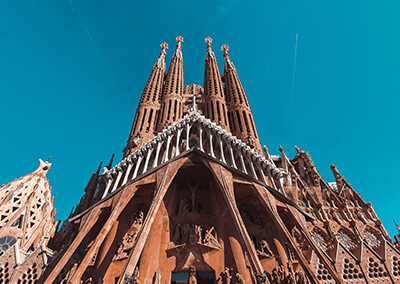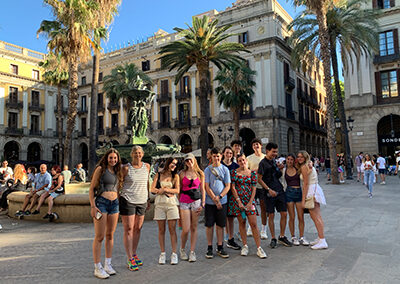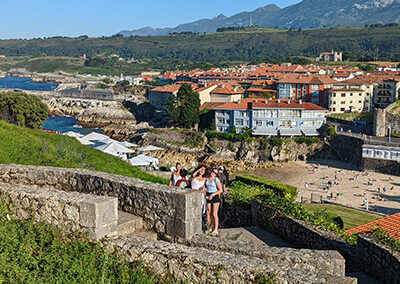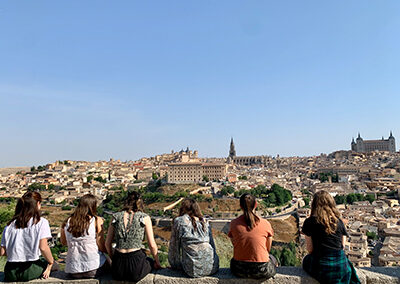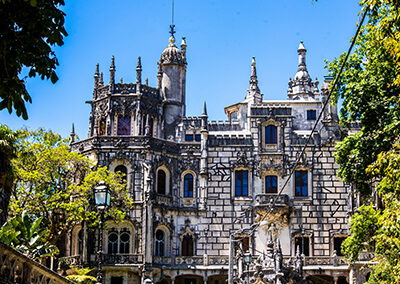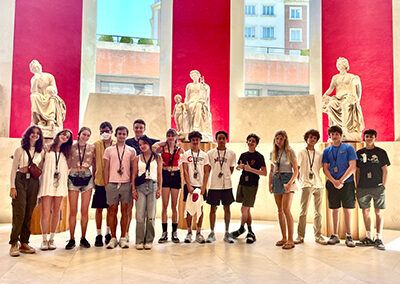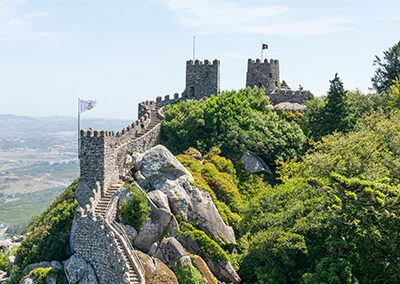Smithsonian Student Travel | Portugal & Spain | NEW
Highlights
-
Learn about Knights Templar rituals at Sintra’s Quinta da Regaleira palace
-
Sample Portuguese petiscos in Lisbon and discover regional Spanish tapas
-
Explore Goya, Picasso, and Dali paintings in Madrid’s world-class museums
-
Discover Gaudí’s revolutionary spires of Barcelona’s Sagrada Familia Basilica
Itinerary
This itinerary represents our plan for the program. However, we may implement changes if we identify opportunities to improve the experience, to take advantage of unexpected events, or to accommodate local schedule changes.
Departure • Travel Day • Meet your student travel group and one of your trip leaders in New York and fly together to Lisbon, Portugal.
Lisbon, Portugal • 4 days • Begin your journey in Lisbon, one of the oldest continually inhabited cities in the world. Stroll past Phoenician ruins that exist side by side with Gothic cathedrals and modern wonders such as the Museum of Art, Architecture, and Technology (MAAT). Learn how Lisbon’s famed seven hills and location at the mouth of the Tagus River influenced its development, and what changes were wrought by the cataclysmic earthquake of 1755. Take a day trip to nearby Sintra, home of several 19th century palaces with vivid pink, yellow, and red walls, a Moorish castle, and a mansion that once housed the initiation ceremonies of the Knights Templar.
Cáceres, Spain • 3 days • From Lisbon, head east into Spain. Stop first in the town of Évora, home to a second century Roman Temple, and then continue on to Cáceres, whose historic old town is a UNESCO World Heritage site where Roman, Islamic, Gothic, and Renaissance structures both blend and compete for attention. Discuss the cultural melting pot which defines this ancient city while sitting in the shade of the olive grove at the heart of the Jewish Quarter, and see vestiges of the multi-tower defense system built by the Moorish rulers in the 11th and 12th centuries.
Madrid, Spain • 3 days • By contrast to Cáceres and Lisbon, Madrid is a relatively new city, with less than 500 years under its belt as an urban center. Delve into some of the modern ideas that influenced its urban planning—from the trade and service neighborhoods surrounding the 18th century palace to the impressive public gardens of Retiro Park, with its glass and iron Crystal Palace and unique monument to “The Fallen Angel.” Visit the second century B.C. Egyptian Temple of Dobod before stepping out on the pitch of the modern-day sports “temple” of Santiago Bernabeu. Here, your Smithsonian Student Travel Expert joins the program to share their insights into Spanish art and culture. Examine modern masterpieces by Picasso and Dalí at the renowned Reina Sofía Museum, and see the dynamic tensions of the everyday lives of royalty and peasant classes as depicted by Goya and Velázquez at the world-class Prado Museum. Step into a modern day polemic as you meet with an architect to examine the impacts of recently reclaimed pedestrian streets that rollback automotive access to the city center.
Barcelona, Spain • 4 days • Even to this day, architects and urban planners around the world look to Barcelona, and in particular Gaudí and his fellow modernists, for inspiration. Peel back layers of this vibrant city, from the cobblestoned Gothic Quarters to the revolutionary grid and courtyard system of the Eixample, to the iconic effusiveness of Gaudí’s Parque Güell, Casa Batlló, and still unfinished Sagrada Familia Basílica. Visit the Picasso Museum, housed inside a medieval palace. This museum holds over 4,000 of the artist’s works. See the ongoing impacts of the 1992 Summer Olympics and the urban renewal that accompanied them and pick one of the city’s many vibrant neighborhoods to do your own architectural use case and redesign survey as a fitting end to your Iberian journey.
Return • Travel Day • Fly from Barcelona, Spain, to New York with your group and a trip leader, then continue on to your final destination.
Smithsonian Student Travel Experts
The expert(s) highlighted below are examples of professionals that will join the group at various points throughout the itinerary to add their expertise and insight to the program theme.

Katryn Evinson, Art Historian
Katryn Evinson holds a Ph.D. in Latin American and Iberian Studies and Comparative Literature from Columbia University (2023) and begins a postdoctoral fellowship in the fall, also at Columbia University. Her dissertation, The Spirit of Sabotage: Contemporary Art and Political Imagination in Post-Industrial Spain, is a study of artistic interventions that react—deploying sabotage tactics—to the role that the promotion of contemporary art will play in Spain’s economic transition toward neoliberalism. Her publications have appeared in boundary2, The Bulletin of Spanish Visual Studies, Chasqui, and LA Review of Books, among others. She teaches on a variety of topics including contemporary Iberian art and literature, feminism, social movements, rural Spain and cultural production, and others. In addition to her research and teaching activities, she is a board member of the Asociación de Literatura y Cine Españoles siglo XXI (ALCESXXI), an editorial assistant for the Revista Hispánica Moderna, a member of the editorial board of Re-visiones, and is currently co-developing a podcast on the question of the rural in the Iberian Peninsula that will be made public soon. Before moving to the US, Katryn spent six years in the international education industry and was the Experiential Learning Coordinator and Service Learning instructor for a study abroad program in Barcelona where she developed a network for college students to volunteer with local organizations. When she’s not deep down into her research and writing, or developing new college courses, Katryn enjoys spending time with her family and friends, going to exhibitions and concerts, running, and watching experimental films.
What to Expect
Physical Activity • This is a physically active summer travel program. You can expect to climb stairs to castle parapets, walk the cobblestone streets of medieval city centers, swim, and go on evening bike rides over the course of the trip. You do not need to be at peak fitness to participate, but it is important that you have a desire to be physically active, and that you are excited about trying all activities.
Accommodations • We stay at hostels and hotels in each city, in a mixture of doubles, triples, and quad rooms, and leaders stay with students throughout the program.
Climate • Summer temperatures in Spain and Portugal can be very warm, with daytime highs in the 80s and 90s °F in Cáceres and Madrid and slightly cooler in the coastal cities of Lisbon and Barcelona.
Meals • A typical day begins with breakfast at our residence, and we enjoy lunches and dinners at small, local restaurants and cafés, or picnic-style in parks and on waterfronts.
Cuisine • Both Portuguese and Spanish cuisine are prime examples of the healthy Mediterranean diet, using high-quality, simple ingredients, which vary regionally and include rice dishes such as paella, olive oil, fresh seafood, a variety of cheeses, grilled vegetables, and delicious, dry-cured jamón serrano.
Enroll in two programs & save $500!
$300 tuition discount + no second application fee

